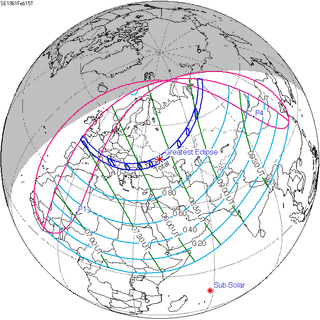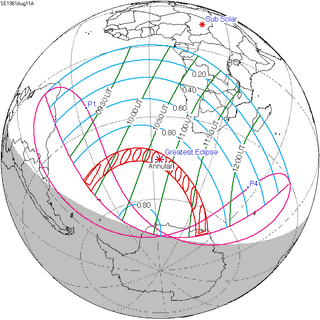Solar eclipse of January 14, 1964
| Solar eclipse of January 14, 1964 | |
|---|---|
 Map | |
| Type of eclipse | |
| Nature | Partial |
| Gamma | -1.2354 |
| Magnitude | 0.5591 |
| Maximum eclipse | |
| Coordinates | 68°12′S 43°06′E / 68.2°S 43.1°E |
| Times (UTC) | |
| Greatest eclipse | 20:30:08 |
| References | |
| Saros | 150 (14 of 71) |
| Catalog # (SE5000) | 9428 |
A partial solar eclipse occurred on January 14, 1964. A solar eclipse occurs when the Moon passes between Earth and the Sun, thereby totally or partly obscuring the image of the Sun for a viewer on Earth. A partial solar eclipse occurs in the polar regions of the Earth when the center of the Moon's shadow misses the Earth.
Related eclipses
Solar eclipses of 1961-1964
Each member in a semester series of solar eclipses repeats approximately every 177 days and 4 hours (a semester) at alternating nodes of the Moon's orbit.
| Ascending node | Descending node | |||||
|---|---|---|---|---|---|---|
| Saros | Map | Saros | Map | |||
| 120 |  February 15, 1961 Total |
125 |  August 11, 1961 Annular | |||
| 130 |  February 5, 1962 Total |
135 |  July 31, 1962 Annular | |||
| 140 |  January 25, 1963 Annular |
145 |  July 20, 1963 Total | |||
| 150 |  January 14, 1964 Partial |
155 |  July 9, 1964 Partial | |||
| Partial solar eclipses of June 10, 1964 and December 4, 1964 belong in the next lunar year set. | ||||||
References
External links
- Earth visibility chart and eclipse statistics Eclipse Predictions by Fred Espenak, NASA/GSFC
| Wikimedia Commons has media related to Solar eclipse of 1964 January 14. |

